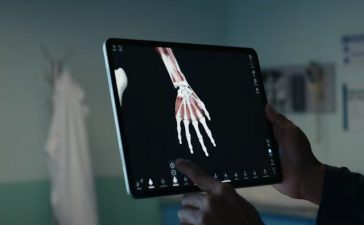When it comes to thinking about Apple Silicon, any industry insider will tell you that there is a long lead time attached to silicon development — meaning development of the chips inside the most modern devices today probably began several years ago.
Zoom out and think back 13 years to the first real Apple Silicon chip, the A4 processor Apple put inside the iPhone 4 in 2010. That early processor reflected major strategic decisions, including the 2008 purchase of PA Semi and its ongoing work with ARM, which still creates the reference designs Apple uses at the core of its own chips.
Apple has continued to iterate upon the first Apple Silicon iPhone chip. Today’s iPhones run A17 processors, while Macs have already reached M3 status. Apple is now unique in the industry in being able to offer 3-nanometer processors across its mobile and computer devices.
These aren’t the only processors the company makes — think about the S1-S9 SiP’s used in the Apple Watch and HomePod; the W-series Bluetooth/Wi-Fi chips; the H1 and H2 headphone processors, even the U2 everyone wants inside of an iPhone, which handles Ultra Wideband.
Coming soon, you’ll see the first R-series processor destined to mold reality inside of Vision Pro. At a lower level, Apple has sensors, power management, and RF networking designs emanating from the silicon design workshops in Europe, US, and Israel. These are huge investments. The European silicon design center in Munich, Germany, now employs more than 4,600 people. And we think Apple is working to build and design systems for 5G modems (delayed), photography sensors, and more.
The pillars: performance and efficiency
What’s important to understand is how the company sees these efforts. For that, you should focus on principles of constraint. Apple has worked with numerous constraints almost since inception.
Think about the PowerPC chips that drove Macs before Apple’s move to Intel. Compared to everyone else, those processors were really slow, which drove Apple to get really good at tweaking the best possible performance out of processors over which it had little or no control. That’s where it doubled down on controlling the software and hardware designs and making sure they worked together.
That mission didn’t end when Apple shifted to Intel, and it hasn’t ended now that all Apple’s products use Apple Silicon. Take a look at everything the company tells you about new products as they’re introduced, and you’ll see that computational performance per watt is a central pillar to Apple’s chip design philosophy.
Throughout the history of Apple Silicon, Apple has needed to focus on problems others don’t have. Market share for those early iPhones grew incredibly fast, which drove the company to seek out some way to build high-performance processors that ran well on little energy and were capable of delivering good results on frugal memory.
But the primary problem across the last decade relates to power and performance. That need drove development of processors for iPhone, and that work now feeds directly into the Mac chips, which deliver (Apple claims) equal performance as comparable PCs at half the energy requirements.
Getting more from less
In theory, at least, you don’t need to pour tons of high-performance, high-energy-consumption memory inside a Mac to make it run efficiently, because all those lessons in getting more from less have fed directly into the design of the system, the processor, and the software they run.
Today’s most powerful Apple laptops deliver just as much computational performance when run on battery as they do when they are plugged in — a direct inheritance from the company’s work on iPhone chips, and Apple Silicon.
The work makes for true all-day battery life in pro Macs, and means Apple’s high-end machines can crunch through the most advanced tasks, from computer aided design to data analysis and the creation of highly realistic virtual environments for movies, games and more.
This is not to neglect that several generations of Apple processors also have dedicated on-chip spaces for artificial intelligence, graphics, and essential performance. All this experience feeds into other unique on-chip advantages Apple now enjoys, including unified memory which in many senses articulates the same challenges Apple has always had — getting more from less.
But this history is already in the rear view
All of these improvements sound great, but once you zoom out and recognize that the advantages we enjoy in Apple’s systems today reflect strategic decisions made several years ago, it becomes easier to estimate the direction of travel.
We know 3nm chips will be followed by 2nm and then, conceivably, 1nm processors. But at some point, the cost of chip manufacturing innovation relating to die size will become too high in comparison to the benefits.
But chip efficiency isn’t merely about die size. Think about lithographic improvement, on-chip silicon efficiencies such as 5G modems within the SoC, even the use of new materials.
Getting more from less also extends to the features inside computers, such as the camera, display, or battery technology. Surprise, surprise, even as Apple takes another leap ahead with M3 Macs, rumors emerge that Apple’s silicon design teams are exploring ways to unlock system efficiency by building solutions for all three.
While the easy assumption is that Apple wants to bring these designs in house because its deeply controlling, I don’t think that’s the case. What this means is that while searching for system-level improvements across its ecosystem, Apple recognizes the need to push hardware to the edge of its capabilities to realize incremental performance efficiencies across its systems that together deliver real improvements.
Playing the long game
As I wrote, silicon development has a long timeline characterized by rounds of invention and review. With this in mind, it’s a complete certainty Apple is already developing Mac processors it doesn’t plan to introduce until 2026 or later, and that these will field on-chip technologies no one outside its labs have even heard of today.
It is also food for thought to imagine the M3 MacBook Pro I really should be writing this article on probably reflects decisions Apple took before the first M1 Macs were even introduced.
And we can reflect on the $30 billion Apple spent on research and development across its 2023 financial year. Back in 2010, when the company shifted its first Apple Silicon chips, R&D spending stood at $1.8 billion. In chip development, at least, some of this money is already being invested in a long game.
Please follow me on Mastodon, or join me in the AppleHolic’s bar & grill and Apple Discussions groups on MeWe.
Copyright © 2023 IDG Communications, Inc.












